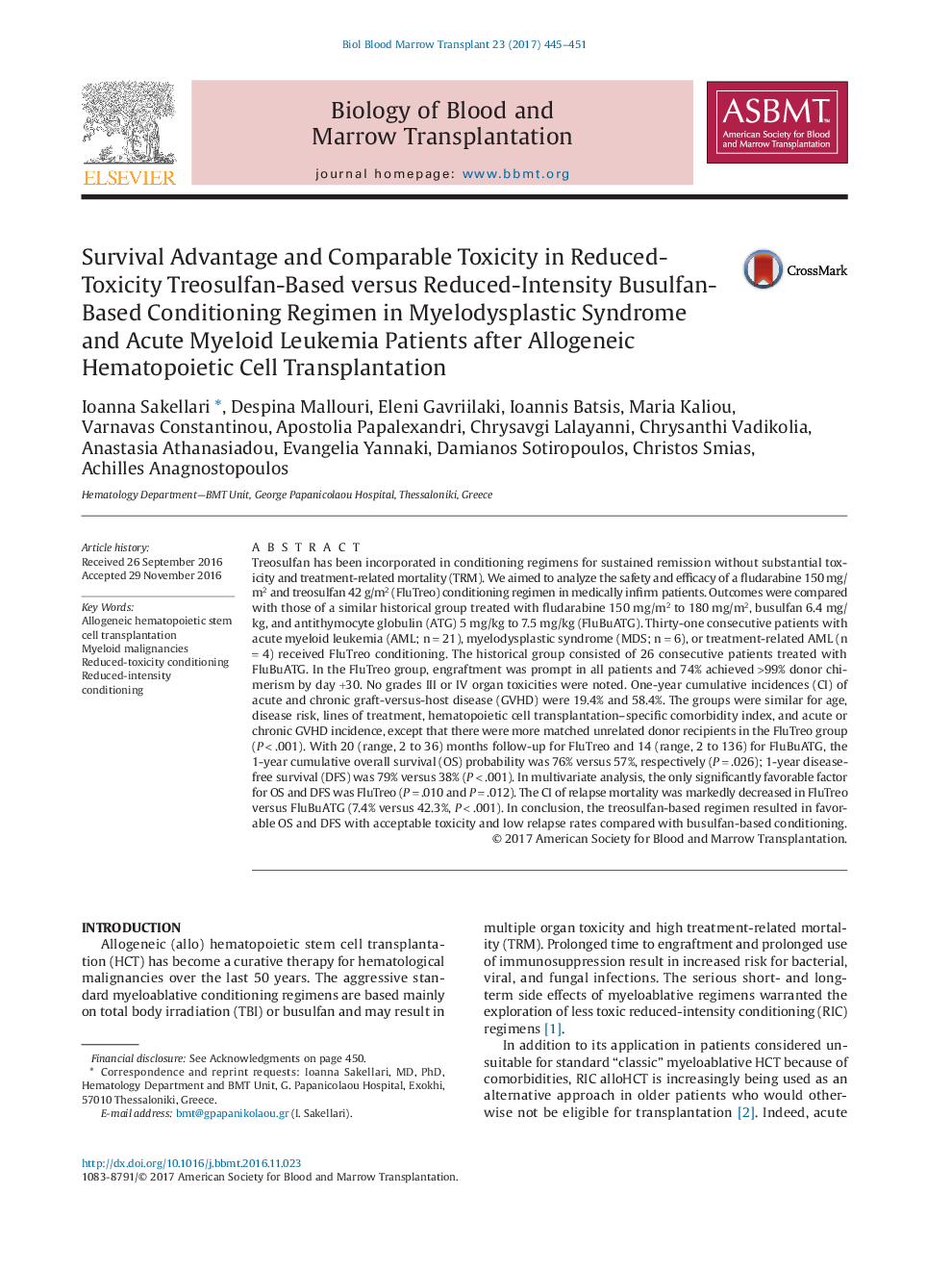| کد مقاله | کد نشریه | سال انتشار | مقاله انگلیسی | نسخه تمام متن |
|---|---|---|---|---|
| 5524216 | 1546243 | 2017 | 7 صفحه PDF | دانلود رایگان |
- A treosulfan-based reduced-toxicity regimen, FluTreo, achieved favorable outcomes in medically infirm acute myeloid leukemia and/or myelodysplastic syndrome patients
- Outcomes were compared to a historical group that received a reduced intensity busulfan-based conditioning (FluBuATG)
- The FluTreo group achieved higher survival rates with low relapse mortality, similar toxicity and transplantation-related mortality
- FluTreo conditioning was the only independent factor associated with favorable survival rates
Treosulfan has been incorporated in conditioning regimens for sustained remission without substantial toxicity and treatment-related mortality (TRM). We aimed to analyze the safety and efficacy of a fludarabine 150âmg/m2 and treosulfan 42âg/m2 (FluTreo) conditioning regimen in medically infirm patients. Outcomes were compared with those of a similar historical group treated with fludarabine 150 mg/m2 to 180âmg/m2, busulfan 6.4âmg/kg, and antithymocyte globulin (ATG) 5 mg/kg to 7.5âmg/kg (FluBuATG). Thirty-one consecutive patients with acute myeloid leukemia (AML; n = 21), myelodysplastic syndrome (MDS; n = 6), or treatment-related AML (n = 4) received FluTreo conditioning. The historical group consisted of 26 consecutive patients treated with FluBuATG. In the FluTreo group, engraftment was prompt in all patients and 74% achieved >99% donor chimerism by day +30. No grades III or IV organ toxicities were noted. One-year cumulative incidences (CI) of acute and chronic graft-versus-host disease (GVHD) were 19.4% and 58.4%. The groups were similar for age, disease risk, lines of treatment, hematopoietic cell transplantation-specific comorbidity index, and acute or chronic GVHD incidence, except that there were more matched unrelated donor recipients in the FluTreo group (Pâ<â.001). With 20 (range, 2 to 36) months follow-up for FluTreo and 14 (range, 2 to 136) for FluBuATG, the 1-year cumulative overall survival (OS) probability was 76% versus 57%, respectively (Pâ=â.026); 1-year disease-free survival (DFS) was 79% versus 38% (Pâ<â.001). In multivariate analysis, the only significantly favorable factor for OS and DFS was FluTreo (Pâ=â.010 and Pâ=â.012). The CI of relapse mortality was markedly decreased in FluTreo versus FluBuATG (7.4% versus 42.3%, Pâ<â.001). In conclusion, the treosulfan-based regimen resulted in favorable OS and DFS with acceptable toxicity and low relapse rates compared with busulfan-based conditioning.
Journal: Biology of Blood and Marrow Transplantation - Volume 23, Issue 3, March 2017, Pages 445-451
